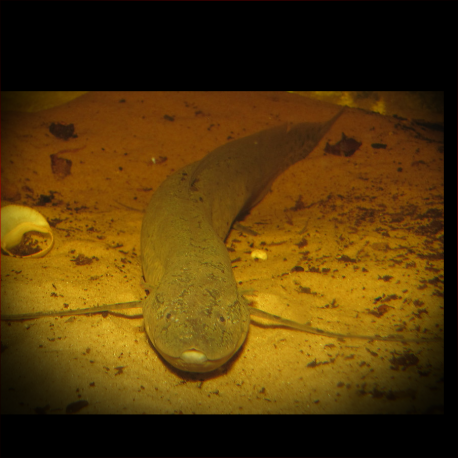More info
Datasheet
| Minimum Tank Size | 1060 litres / 280.02 US gallons |
| Maximum Size | 10.0cm / 3.94inches |
| Temperature | 24°C / 75.20°F - 30°C / 86.00°F |
| Hardness | 0-10ºdH |
| pH | 6.0-7.0 |
General Description
Lungfish, specifically the Protopterus Annectens Annectens species, are ancient fish that have remained virtually unchanged for millions of years. They possess both gills and lungs, allowing them to breathe underwater with rudimentary gills and rise to the surface periodically to obtain atmospheric air through the lungs. These fish have long, thin, and fleshy limb-like fins used primarily for touch and crawling across dry land if necessary. Additionally, lungfish exhibit adaptations in their swim bladder, heart structure, bony arrangements, and blood flow that resemble primitive amphibians.
Aquarium Setup
For keeping African Lungfish in an aquarium, a minimum tank size of 1060 litres is necessary. Water movement should be minimal, and the decor can include roots, branches, or large smooth rocks for cover. Artificial lighting must be dim, and a sandy or muddy substrate, while beneficial, is not essential. Crucially, the tank cover must be secure with no gaps that the lungfish could exploit for escape, as they are known to be escape artists. An essential consideration is to leave a gap of approximately 6 inches between the water surface and the tank cover to enable the fish access to the atmospheric air vital for their survival.
Behaviour
African Lungfish are best kept solitary as they are unpredictable and have been observed to become aggressive towards tankmates after being kept in a community setting. Lungfish are known to be intolerant of their conspecifics and are not suitable for communal setups with other fish species due to their ability to inflict severe bites without warning.
Feeding and Diet
Protopterus Annectens Annectens are omnivorous, consuming fish, shellfish, amphibians, and plant matter in their natural habitat. In an aquarium environment, they readily adapt to various foods, including prawn, mussel, lancefish, algae wafers, and other vegetable matter. Larger lungfish can be fed whole fish like trout or sprats. Interestingly, they do not require daily feeding and can survive without any food for over three years.
Reproduction & Dimorphism
Successfully breeding African Lungfish in captivity remains a challenge, as spawning has not yet been achieved. In the wild, lungfish build nests for egg deposition, which are guarded by the male until hatching. Information regarding sexual dimorphism in this species is currently unknown.
Habitat and Distribution
African Lungfish, found in a wide range of countries including Sierra Leone, Guinea, Togo, and Nigeria, typically inhabit temporary floodplains that dry up seasonally. They also reside in swamps, marshes, and backwaters, showcasing their adaptability to survive in varying aquatic environments.

